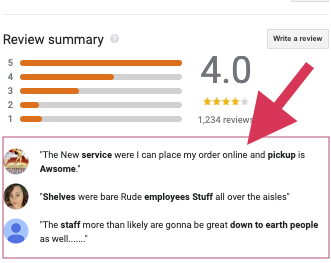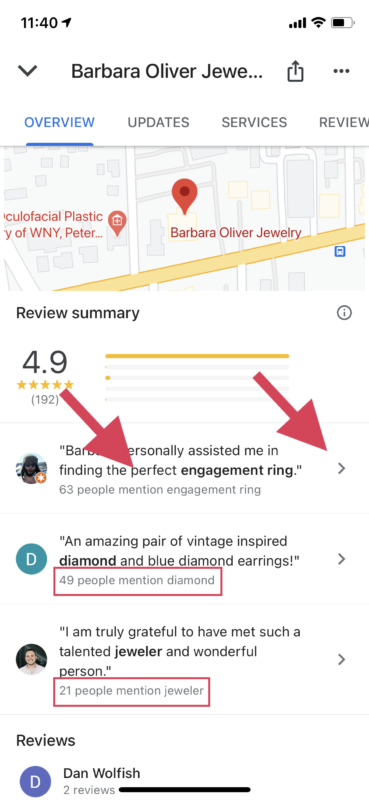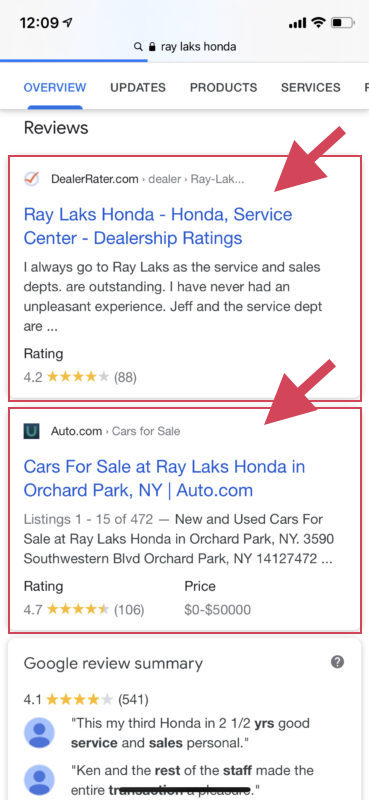Google review summaries are valuable to your business listing in search results because the content stands out and can drive purchases, but it can also be really baffling how the summaries actually work or how you can affect them.
The information around review summaries is vague and it’s often unclear why one summary or snippet is chosen versus another. Because of this ambiguity, it’s difficult for businesses to define a path to improvement.
That being said, when Google does make updates from time to time, there are a few things we can glean. Here’s the latest understanding of Google review summaries (with the provision that things will eventually change again) and how you can take advantage of them.
What is a Google review summary and how does it work?
A Google review summary, also referred to as review snippets, is a rich result type that generally consists of three abbreviated sentences — or excerpts — from customer reviews. The review summary is shown in your Google business listing and attempts to capture a snapshot of your business.
The snippets are eye-catching pieces of content that give potential customers more information about your brand or business so they feel confident in buying from you. When people do an online search and want quick social proof or an easy way to compare your business to your competitors, they can glance at the Google review summary. Review summaries can also drive more traffic to your website, which boosts search engine optimization (SEO).
In mobile search, these review summaries exist as a standard individual card farther down the page. In desktop search, they are part of the business profile.
The challenge is that Google automatically creates the review summaries or snippets for you using an algorithm, so you don’t have much control over what appears (with one caveat that we’ll discuss below).
However, if you have reviews and ratings structured data set up, you can monitor your review snippets in the Search Console of your Google account using review snippet reports. These reports show you how the rich result type improves your performance and if there are any issues to address. The various reports allow you to review existing URLs, notice any errors or warnings, and fix markup code so that Google will recrawl pages.
One of the downsides of Google review summaries is that if you have around a 4.3 star rating or below, Google seems to frequently show one negative sentiment in the mix — without an explanation as to why it’s included or how you might go about changing it.

In fact, whether you see positive or negative snippets in the review summary seems to strongly correlate with the rating. For 4.4 stars and above, you typically only see positive snippets. In the 3.9 to 4.3 range, you typically see one negative snippet. And often for the lower-rated businesses, you will see two or even three negative snippets.
Therefore, one way to avoid negative snippets appearing at all is to have a preponderance of good reviews and a 4.5 star rating or higher — which we’ll discuss more below.
What’s in the Google Maps app review summary?
In the desktop and mobile Google Maps app, there is a Google review summary technique that shows review summaries based on the most common Place Topics. These are business-specific attributes extracted from the review content using some form of sentiment analysis.
The display in the Google Maps mobile app for both Android and iPhone shows review summaries based on the Place Topics. Topics with the highest frequency seem to drive the review snippet choice and link out to the body of reviews containing the topic-specific keyword or phrase.
Remember earlier how we said there’s one caveat to not being able to control review snippets? This seems to be the one area in which you can exercise some control, since Google claims that you can select the snippet that will take people over to all the reviews related to that topic — presumably when you’re logged in to manage your Google Business Profile.

Note the Places Topic count below the snippet and the arrow that takes the user to see reviews on that topic.
Google still shows third-party review summaries
Another interesting change is the new third-party review summary cards that are now being shown on the mobile browser brand search results. Google is including these summary cards for third-party sites above the Google review summaries. Note that to see these new cards, you need to be in an industry with lots of review sites and scroll pretty far down the page, below the images and busy hours.

Interestingly, these third-party review site cards are in addition to the review sites that appear in the Reviews from the web section in the top-level business profile. Thus, they are typically only visible in industries like automotive, dental, medical, and restaurants for which there are a large number of both general and vertical review sites.
These third-party review summaries appear to be dynamically generated when there are additional available review sites in addition to the ones that show above the fold. To find verticals in which they are visible, first find categories in which there are a lot of review sites, identify some busy businesses with a fair number of reviews, and then do a brand search on it. Clearly Google is elevating additional review sites with rich snippets to page one of mobile search results. We have long known that Google sees third-party reviews as a form of web reference that is of greater importance than a basic citation.
It also appears that there is some minimum number of reviews for these pages to be highlighted and summarized. The assumption is that there needs to be at least 10 reviews for summaries to show, but the actual minimum number is still to be determined.
This third-party review summary card effectively pushes the Google review summary farther down the web results page. In highlighting these additional third-party sites where a business has reviews, Google is increasing their visibility and brand value. From a tactical point of view, this makes the case for gathering enough reviews on these sites so that they are visible in your search results.
How can you improve your review snippets?
As we’ve discussed, you can’t necessarily impact what is selected and shown in the Google review summary. But there are a few steps you can take to improve your review snippets as part of your overall online reputation management and customer experience strategy.
Your first focus should always be on improving your business so that you can achieve a 4.5 star rating or above. This will likely make any negative review snippets disappear from the review summary.
In Google Maps, it appears that having more reviews with Place Topics from highly rated areas of your business might also help get rid of the negative snippets.
As far as your search results that appear in the mobile browser, while it still uses the old style of sentiment analysis, getting more reviews on third-party sites will tend to push the Google review summary farther down the page — which can minimize its impact if you do have a negative snippet or two.
So while review snippets can be frustrating to understand and work with, there are a few things you can do here and there that will help you — if not entirely control your review summary content — then at least better understand how the review snippets might impact your business listing. Of course, the hope is also that Google will become more transparent at some point in how the snippets are chosen and perhaps provide some tools that will allow you to take concrete steps to affect what appears in your Google review summary.
To learn how GatherUp’s reputation management platform can help you get more Google reviews and manage your review strategy, start your free trial today.

Comments are closed.